Nutritious | Budget-Friendly | Chicken Recipe
Balsamic Chicken with Lemon is an easy-to-make main meal recipe that is loaded with Mediterranean flavors. Succulent and juicy oven-baked chicken pieces cooked in the rich, tangy flavors of balsamic vinegar with the bright, zesty notes of fresh lemon.
Finished with a beautiful caramelized sauce, Balsamic Chicken with Lemon is an easy-to-make yet elegant dish that’s perfect for any weeknight dinner or special occasion.
This recipe is ready in under 1 hour and makes a main serving for 6 people when served alongside some steamed rice or your favorite grain. We suggest serving it with a green salad or your favorite steamed veggies for a healthy and balanced meal.
Table of contents:
Why you’ll love this recipe
- Easy oven-baked chicken recipe
- Can be made in one large casserole dish
- Tangy balsamic and lemony flavors are amazing!
- Nutritious and healthy meal
- High in protein
- High in Iron
How to Make Balsamic Chicken with Lemon
Ingredients
For the marinade
- ¼ cup Extra Virgin Olive Oil
- 4 garlic cloves, minced
- 1 teaspoon Onion Powder
- 1 teaspoon Dried Oregano
- 2 tablespoons of honey
- ¼ cup Balsamic Vinegar
- 2 tablespoons tomato paste
- All-purpose flour (optional for thickening sauce)
For the chicken
- 35 oz. (1 kg) chicken pieces (legs, thighs, etc)
- 1 large onion, thinly sliced
- 1 lemon, sliced into rounds
Equipment
- Large Glass bowl
- Large Oven-Safe Casserole Dish
- Fork or spoon
- Cooking tongs
- Oven
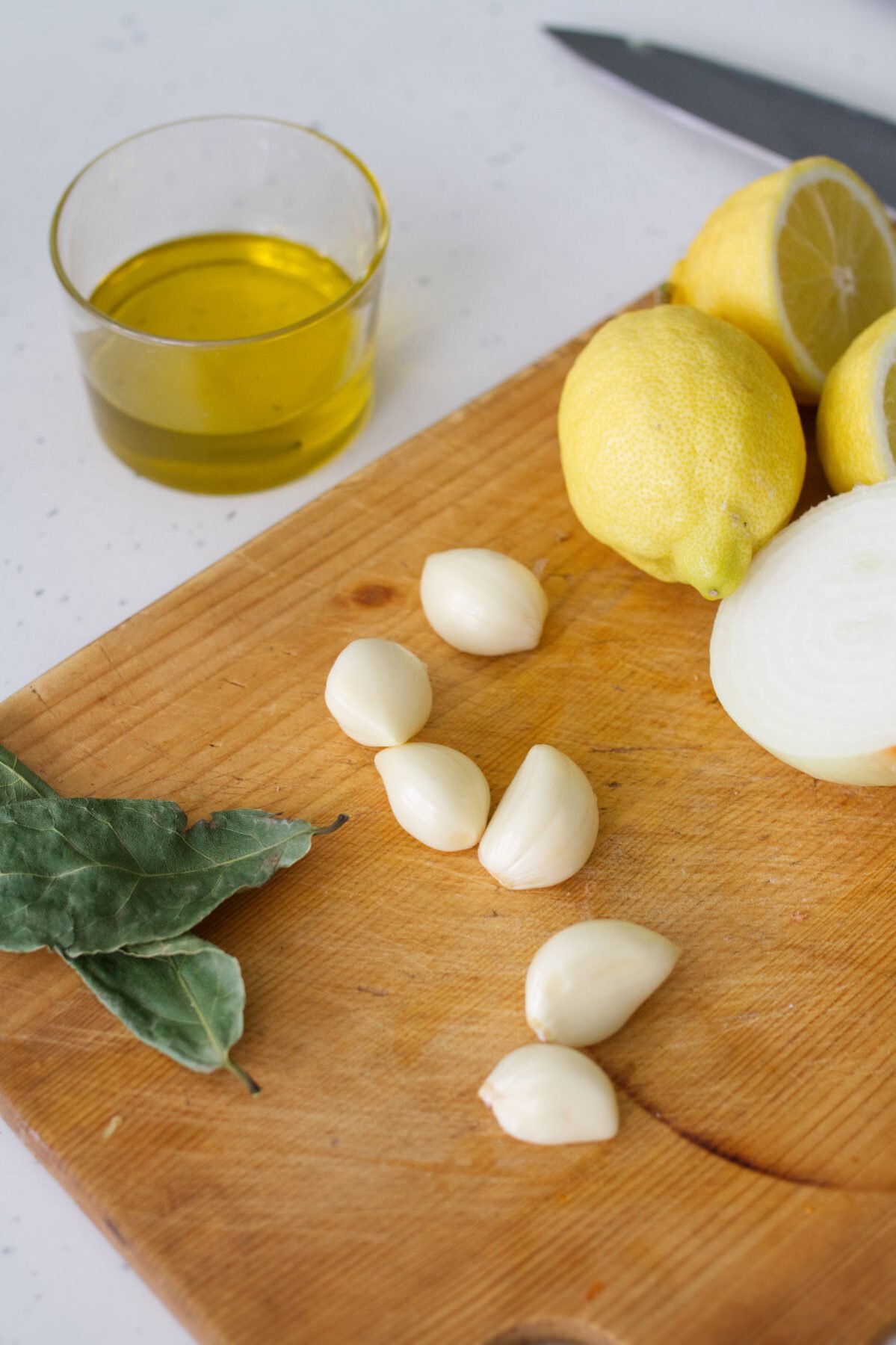
Instructions
Preheat oven 400°F/200°C.
Step 1 – Prepare Marinade
Add all of the marinade ingredients into a large bowl and mix well.
Add chicken pieces and marinade for 5-10 minutes while oven warms up.
Add onion and combine with chicken pieces and marinade.
Add 2 tablespoons of tomato paste, mix well and set aside.
Step 2 – Add to a Casserole Dish
Transfer ingredients to a large oven-safe casserole dish.
Add sliced lemon rounds between chicken pieces.
Step 3 – Bake Chicken
Place into the oven and bake for 20 minutes, and then rotate the chicken pieces in the sauce. Return to the oven and cook for another 10-15 minutes or until chicken is cooked through. Plenty of sauce will be in the bottom of the dish which begs some steamed rice for a good mop up.
Before serving, use a meat thermometer to check the internal temperature of the chicken has reached 165°F/74°C.
Step 4 – Time to Serve
Serve with some steamed rice and your favorite steamed greens or veggies.
Cooking Tips:
- If you want an extra thick sticky sauce, substitute balsamic glaze for the balsamic vinegar.
- To thicken the sauce without using balsamic glaze, mix the marinade ingredients in a small bowl and slowly add more honey and all-purpose flour. Around 1-2 tablespoons of flour is plenty and will give the sauce a much thicker consistency once it is cooked with the chicken.
- We used a few cuts of bone-in chicken for this recipe (thigh, drumstick, quarters), however, boneless or bone-in chicken thighs will also work great. Chicken quarters will also work, just ensure you adjust the cooking time to suit if the chicken cuts used are thicker than 1.5 inches.
- As noted above in the instructions, before serving, use a meat thermometer to check the internal temperature of the chicken has reached 165°F/74°C.
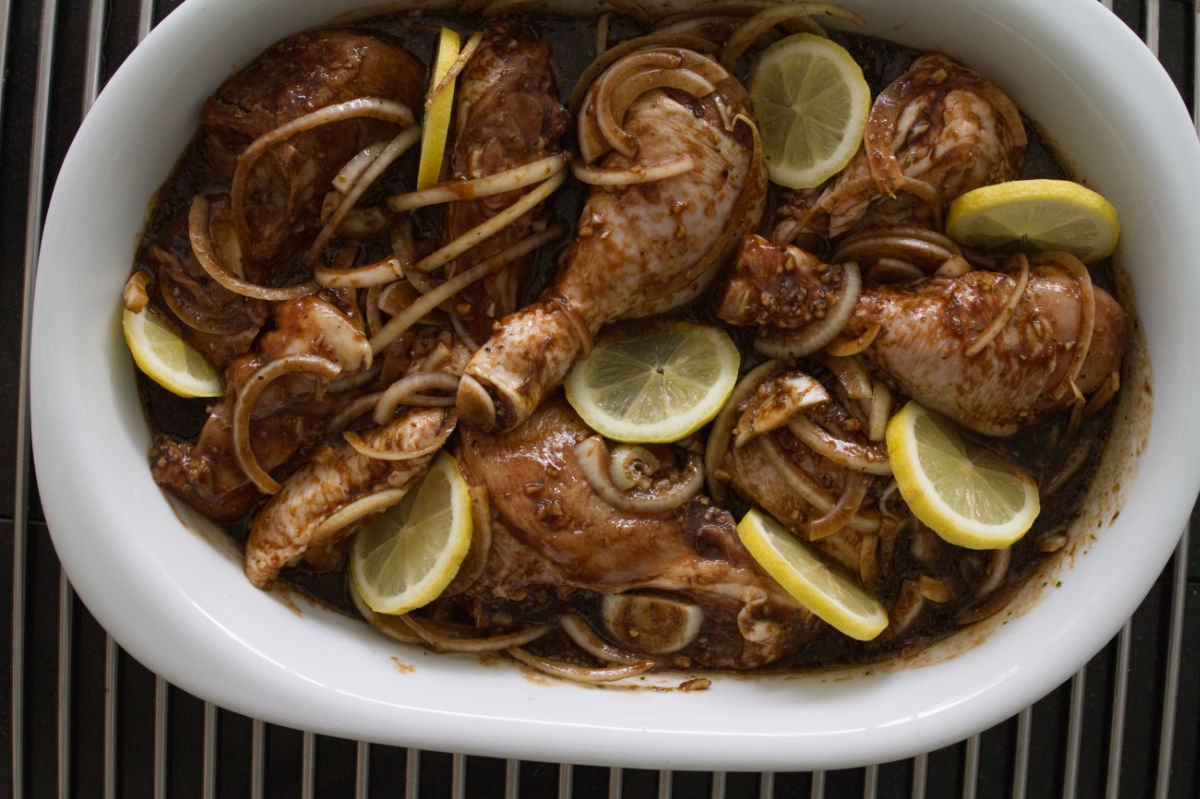
Origin of Balsamic Vinegar
Balsamic vinegar, known for its rich and complex flavor, originates from the Emilia-Romagna region of Italy, particularly the provinces of Modena and Reggio Emilia. The region’s capital is the city of Bologna which is located above Florence (Tuscany). Emilia-Romagna is one of the wealthiest and most developed regions in Europe and is also home of the University of Bologna, the oldest university in the world
Balsamic vinegar is considered a traditional Italian condiment that has a history that dates back to the Middle Ages (around the 11th century).
How Balsamic Vinegar is Made
Initially, balsamic vinegar was made by local families, who used it both as a condiment and for medicinal purposes. During the Renaissance, balsamic vinegar’s reputation grew, becoming a favored product among European nobility. It was often included in dowries and given as prestigious gifts. The production techniques were passed down through generations, with each family developing its own closely guarded recipe.
The traditional production of balsamic vinegar involves a meticulous and time-consuming process. Balsamic vinegar is made from the must (freshly crushed grape juice) of Trebbiano and Lambrusco grapes. The grapes are then cooked down until they become a thick syrup, which is then fermented and aged in wooden barrels (called ‘batteria’ in Italian).
The aging process can last anywhere from 12 years to over 25 years, although the balsamic vinegar that is commercially available today has a considerably shorter aging time.
Today, authentic traditional balsamic vinegar is recognized with Protected Designation of Origin (PDO) status, ensuring that only vinegar produced in Modena and Reggio Emilia using traditional methods can be labeled as “Aceto Balsamico Tradizionale.”
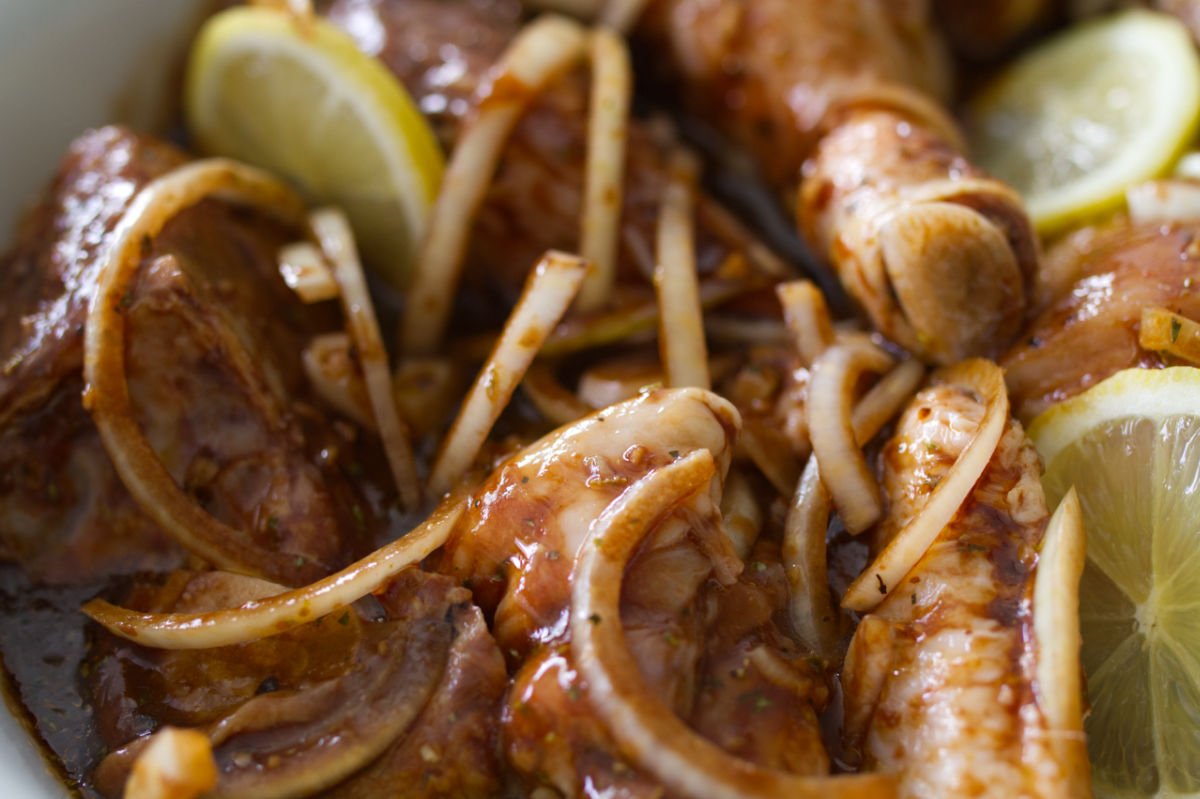
Types of Balsamic Vinegar
- Traditional Balsamic Vinegar (Aceto Balsamico Tradizionale):
– This is the highest quality balsamic vinegar, aged for a minimum of 12 years and often much longer.
– It has a rich, complex flavor profile and is typically used as a finishing condiment.
- Commercial Balsamic Vinegar:
– Less expensive and aged for a shorter period, often mixed with wine vinegar and caramel to simulate the sweetness and color of traditional balsamic vinegar.
– Used in cooking, dressings, and marinades. We suggest using this type of balsamic vinegar for this recipe.
Culinary Uses of Balsamic vinegar
Balsamic vinegar is a versatile ingredient in both traditional Italian and modern cuisine. It can be drizzled over salads, vegetables, meats, and even fruits and desserts.
This recipe uses balsamic vinegar as the base for a marinade and adds honey, tomato paste, herbs, and spices to create a rich and flavorsome sauce. Allowing some time for the marinade to soak into the chicken pieces yields delicious juicy chicken pieces that are tangy and rich with flavor.
Why You Should Use Balsamic Vinegar in Your Cooking!
Balsamic vinegar is a versatile and flavorful ingredient that can enhance a wide range of dishes. While most of us living in Europe are used to seeing it used as a condiment for salad dressings, balsamic vinegar can be used in just about any recipe, adding depth and flavor quickly and easily.
Here are just a few reasons why you should consider using balsamic vinegar in your cooking:
1. Rich and Complex Flavor
- Depth of Flavor: Balsamic vinegar has a unique balance of sweetness and acidity, providing a rich and complex flavor that can elevate simple dishes.
- Variety: There are different types of balsamic vinegar, ranging from the more affordable commercial varieties to the exquisite traditional balsamic vinegar, allowing for varied culinary applications.
2. Enhances Other Ingredients
- Complementary: Balsamic vinegar enhances the natural flavors of ingredients without overpowering them. It works particularly well with tomatoes, strawberries, cheese, and meats.
- Versatility: It can be used in marinades, dressings, glazes, and reductions, adding depth and a touch of sweetness to both savory and sweet dishes.
3. Health Benefits
- Antioxidants: Balsamic vinegar contains polyphenols, which are antioxidants that can help protect the body from oxidative damage.
- Digestive Aid: The acetic acid in balsamic vinegar can aid digestion by promoting healthy gut bacteria and slowing the absorption of sugar, which can help regulate blood sugar levels.
- Low in Calories: It’s a low-calorie ingredient, making it a healthy addition to salads and other dishes.
4. Culinary Versatility
- Salads and Dressings: Balsamic vinegar is a classic ingredient in salad dressings. It pairs well with olive oil to create a simple yet flavorful vinaigrette.
- Marinades: It tenderizes meat and infuse it with flavor. A balsamic marinade can make chicken, beef, or pork dishes more succulent and tasty.
- Sauces and Glazes: Reduced balsamic vinegar makes a great glaze for vegetables, meats, and even fruits. It can be drizzled over roasted vegetables or grilled meats to add a glossy finish and a burst of flavor.
- Desserts: Its sweet and tangy profile complements desserts. Try it drizzled over strawberries, peaches, or even vanilla ice cream for a sophisticated touch.
5. Easy to Use
- Simple Applications: Just a splash of balsamic vinegar can transform a dish. Whether it’s a caprese salad, a grilled steak, or a simple bowl of fresh berries, a few drops can make a significant difference.
No Special Equipment: You don’t need any special equipment or preparation techniques to use balsamic vinegar. It can be easily incorporated into everyday cooking.
Looking for a quick and easy salad dressing recipe? Check out our quick and easy homemade balsamic vinaigrette recipe here.
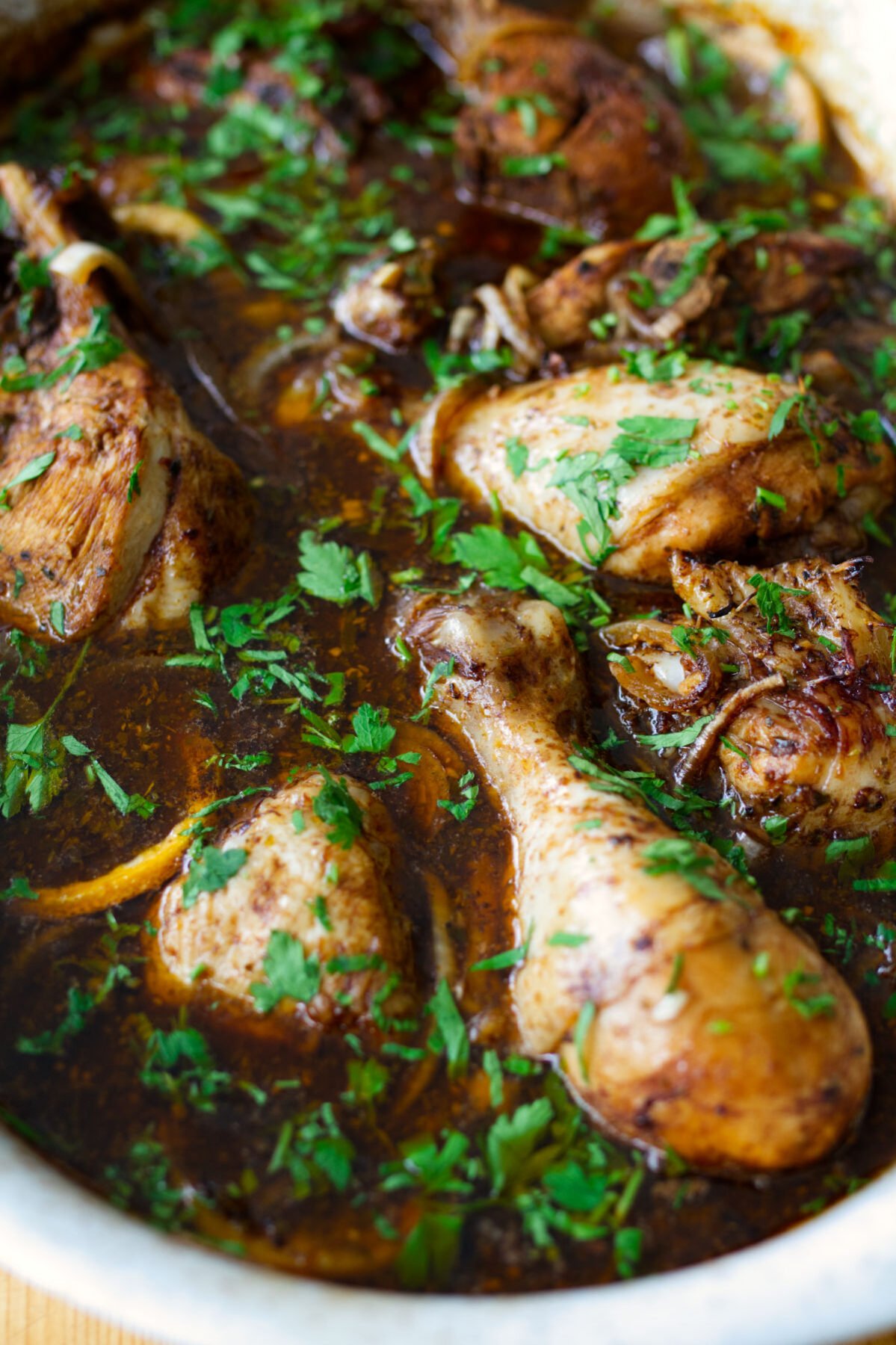
Ingredients and Substitutions
Chicken Pieces:
We used a whole chicken that was cut into pieces, but you can use any cut of chicken you like. Drumsticks work great on their own, and the dark meat of chicken thighs tastes fantastic once they are marinated with rich balsamic and lemony flavors.
We opted for skin-on chicken pieces, but if you want to make this recipe more healthy, use skinless cuts of chicken.
Balsamic Vinegar and Fresh Lemon:
This winning combination helps the marinade tenderize the chicken before it is cooked. Balsamic vinegar adds plenty of depth to the flavor profile and once baked with the chicken becomes rich and sticky in consistency. Use fresh lemon for best results.
Herbs and Spices:
We use a classic combination of Mediterranean herbs and spices for this recipe. Use plenty of dried oregano and dried thyme to give the chicken pieces plenty of herby flavors. Using a combination of paprika, garlic or onion powder, salt, and pepper helps season the dish and gives a rich layering of flavor.
Honey:
Adding honey to the marinade helps to thicken the sauce and adds a delicious sweetness to the dish, complementing the balsamic vinegar and the lemon.
Onion and Garlic:
Another classic combination used in Mediterranean cooking is the use of onion and garlic. The garlic is used to give the marinade some extra pop and flavor, while the onion is used to add texture and flavor. Other veg such as green or red bell pepper could also be welcome additions to this recipe.
Olive Oil: Whenever possible we use good quality extra virgin olive oil for cooking. EVOO is renowned for its numerous health benefits and is considered one of the healthiest oils for consumption. For more information on olive oil, check out our complete article on the role of olive oil in a healthy diet
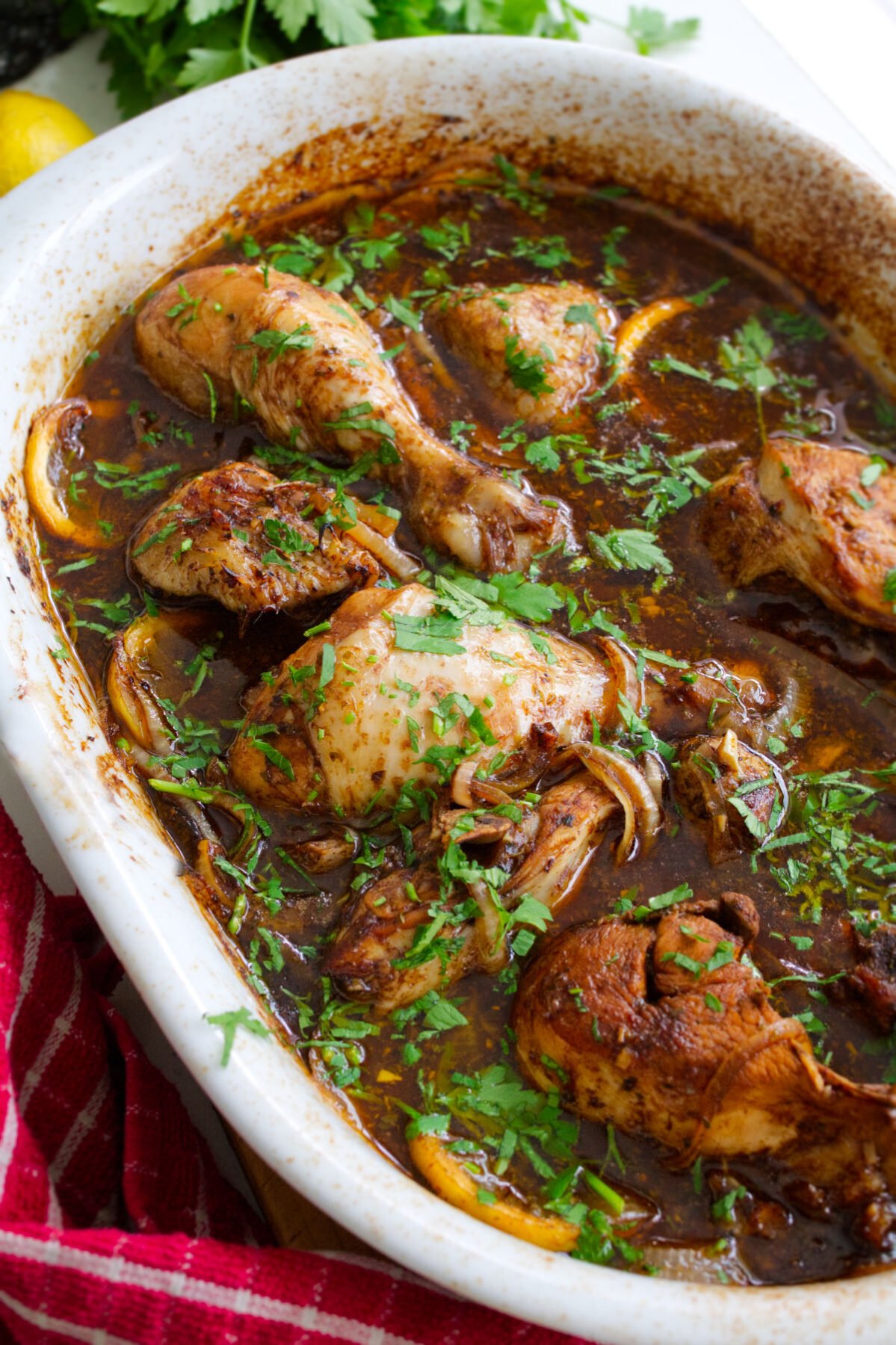
How To Make A Sticky Balsamic Sauce
There are a few ways to thicken the marinade so that when it cooks it becomes a rich and sticky sauce that coats the chicken pieces.
Use a Balsamic glaze:
This method uses a balsamic glaze instead of balsamic vinegar. You can usually find balsamic glaze in the same area of the supermarket where you’ll find balsamic vinegar. The difference is that a balsamic glaze is typically made by reducing balsamic vinegar, often with added sugar or sweeteners to enhance thickness and sweetness.
You’ll notice the difference in consistency when pouring balsamic glaze. It is rich and syrup-like straight from the conatainer.
Use Flour:
Cornflour or all-purpose flour is another way to thicken the marinade. Add around 2 tablespoons of flour and mix it with the other marinade ingredients until you remove all the lumps. It should look thicker and more syruplike before cooking, and add more flour to achieve the desired consistency. Note that the marinade will thicken once it is baked in the oven so be careful not to add too much flour.
Add More Honey:
Adding more honey will also help thicken the marinade. Be mindful that it is also adding sweetness to the dish so we suggest only adding around 2 tablespoons more honey (so that’s 4 tablespoons in total). Mix the honey with the balsamic vinegar until the honey dissolves, then add the other marinade ingredients.
Is Balsamic Chicken with Lemon Healthy?
Like many chicken recipes, balsamic chicken with lemon uses fresh and natural ingredients to provide a flavorful and healthy meal. It is high in protein, high in iron, and high in dietary fiber. A 200g serving contains around 440 calories and should be served alongside your preferred grain and some salad or steamed veggies for a balanced meal.
Be mindful that this recipe contains around 26% of the recommended daily intake of fats, and 23% (4.6 grams) of saturated fats. If you are watching your cholesterol, be aware that this recipe is high in cholesterol and has 137mg or 43% of your suggested daily intake of cholesterol.
Generally speaking, this is a healthy recipe, and most ingredients used are found within the Mediterranean diet. Comparable to other recipes found in Italian cuisine, this is a great option for a nutritious and healthy meal.
Nutrition Facts
| Serving size: 200g | |
| Servings: 6 | |
| Amount per serving | |
| Calories | 440 |
| % Daily Value* | |
| Total Fat 20g | 26% |
| Saturated Fat 4.6g | 23% |
| Cholesterol 137mg | 46% |
| Sodium 124mg | 5% |
| Total Carbohydrate 14.7g | 5% |
| Dietary Fiber 1.7g | 6% |
| Total Sugars 9g | |
| Protein 49.7g | |
| Vitamin D 0mcg | 0% |
| Calcium 58mg | 4% |
| Iron 3mg | 18% |
| Potassium 544mg | 12% |
| *The % Daily Value (DV) tells you how much a nutrient in a food serving contributes to a daily diet. 2,000 calorie a day is used for general nutrition advice. | |
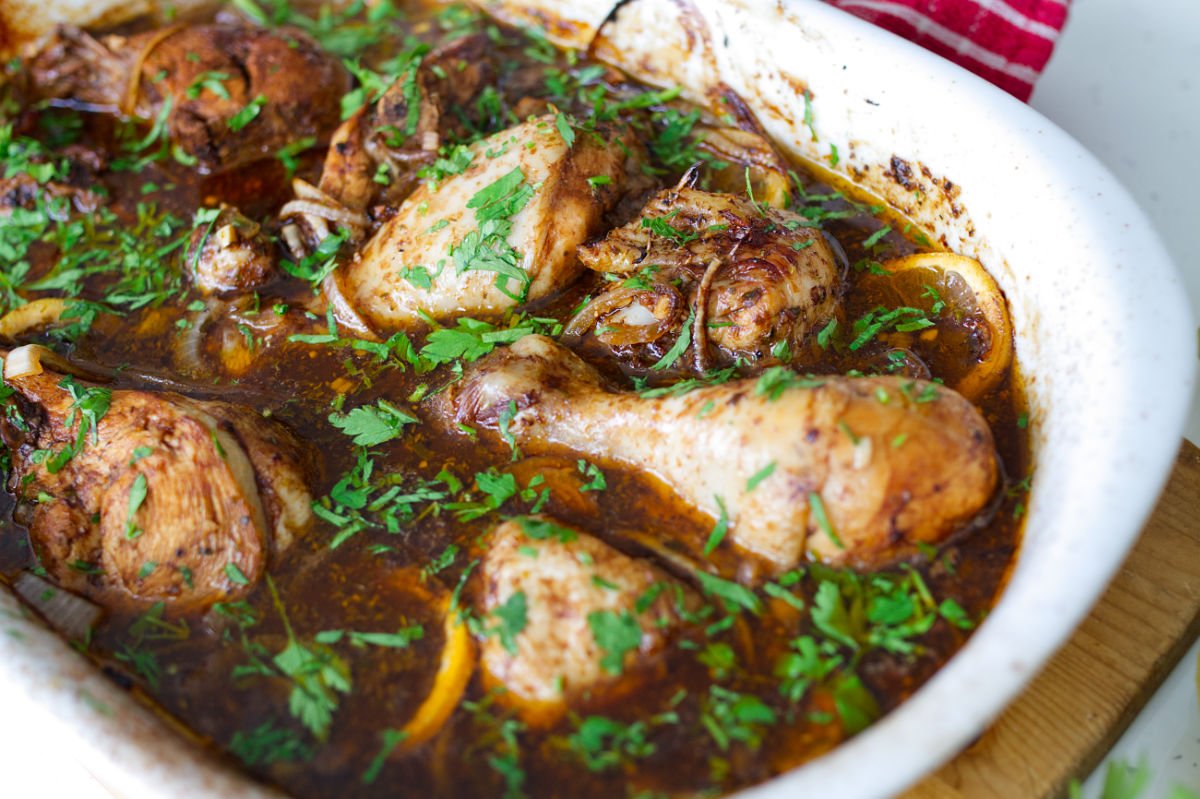
More Mediterranean Chicken Recipes:
- Healthy Mediterranean Chicken in a Tangy Lemon, Oil, and Herb Marinade
- Baked Mediterranean Chicken Thighs
- Pan-fried Greek Chicken Souvlaki With Creamy Tzatziki Sauce
- Za’atar Chicken with Leek, Artichoke Hearts, and Kalamata Olives
- One-pan Greek Chicken thighs with roast veg
- Mediterranean Chicken Meatballs with Couscous and a Tangy Greek Yogurt Dressing
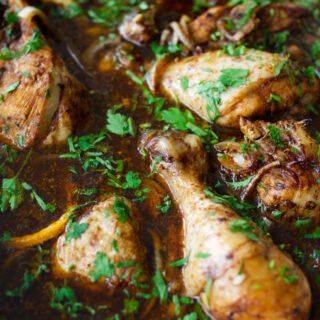
Balsamic Chicken with Lemon
Equipment
- Large bowl
- Large oven-safe casserole dish
- Fork or spoon
- Cooking tongs
- Oven
Ingredients
For the marinade
- ¼ cup extra virgin olive oil
- 4 garlic cloves minced
- 1 teaspoon onion powder
- 1 teaspoon dried oregano
- 2 tablespoons of honey
- ¼ cup balsamic vinegar
- 2 tablespoons tomato paste
- All-purpose flour optional for thickening sauce
For the chicken
- 35 oz. 1 kg chicken pieces (legs, thighs, etc)
- 1 large onion thinly sliced
- 1 lemon sliced into rounds
Instructions
Step 1 – Prepare Marinade
- Preheat oven 400°F/200°C.
- Add all of the marinade ingredients into a large bowl and mix well.¼ cup extra virgin olive oil, 4 garlic cloves, 1 teaspoon onion powder, 1 teaspoon dried oregano, 2 tablespoons of honey, ¼ cup balsamic vinegar, All-purpose flour
- Add chicken pieces and marinade for 5-10 minutes while oven warms up.35 oz. 1 kg chicken pieces (legs, thighs, etc)
- Add onion and combine with chicken pieces and marinade.1 large onion
- Add 2 tablespoons of tomato paste, mix well and set aside.2 tablespoons tomato paste
Step 2 – Add to a Casserole Dish
- Transfer ingredients to a large oven-safe casserole dish.
- Add sliced lemon rounds between chicken pieces.1 lemon
Step 3 – Bake Chicken
- Place into the oven and bake for 20 minutes, and then rotate the chicken pieces in the sauce. Return to the oven and cook for another 10-15 minutes or until chicken is cooked through. Plenty of sauce will be in the bottom of the dish which begs some steamed rice for a good mop up.
- Before serving, use a meat thermometer to check the internal temperature of the chicken has reached 165°F/74°C.
Step 4 – Time to Serve
- Serve with some steamed rice and your favorite steamed greens or veggies.
Video
Notes
Cooking Tips:
- If you want an extra thick sticky sauce, substitute balsamic glaze for the balsamic vinegar.
- To thicken the sauce without using balsamic glaze, mix the marinade ingredients in a small bowl and slowly add more honey and all-purpose flour. Around 1-2 tablespoons of flour is plenty and will give the sauce a much thicker consistency once it is cooked with the chicken.
- We used a few cuts of bone-in chicken for this recipe (thigh, drumstick, quarters), however, boneless or bone-in chicken thighs will also work great. Chicken quarters will also work, just ensure you adjust the cooking time to suit if the chicken cuts used are thicker than 1.5 inches.
- As noted above in the instructions, before serving, use a meat thermometer to check the internal temperature of the chicken has reached 165°F/74°C.

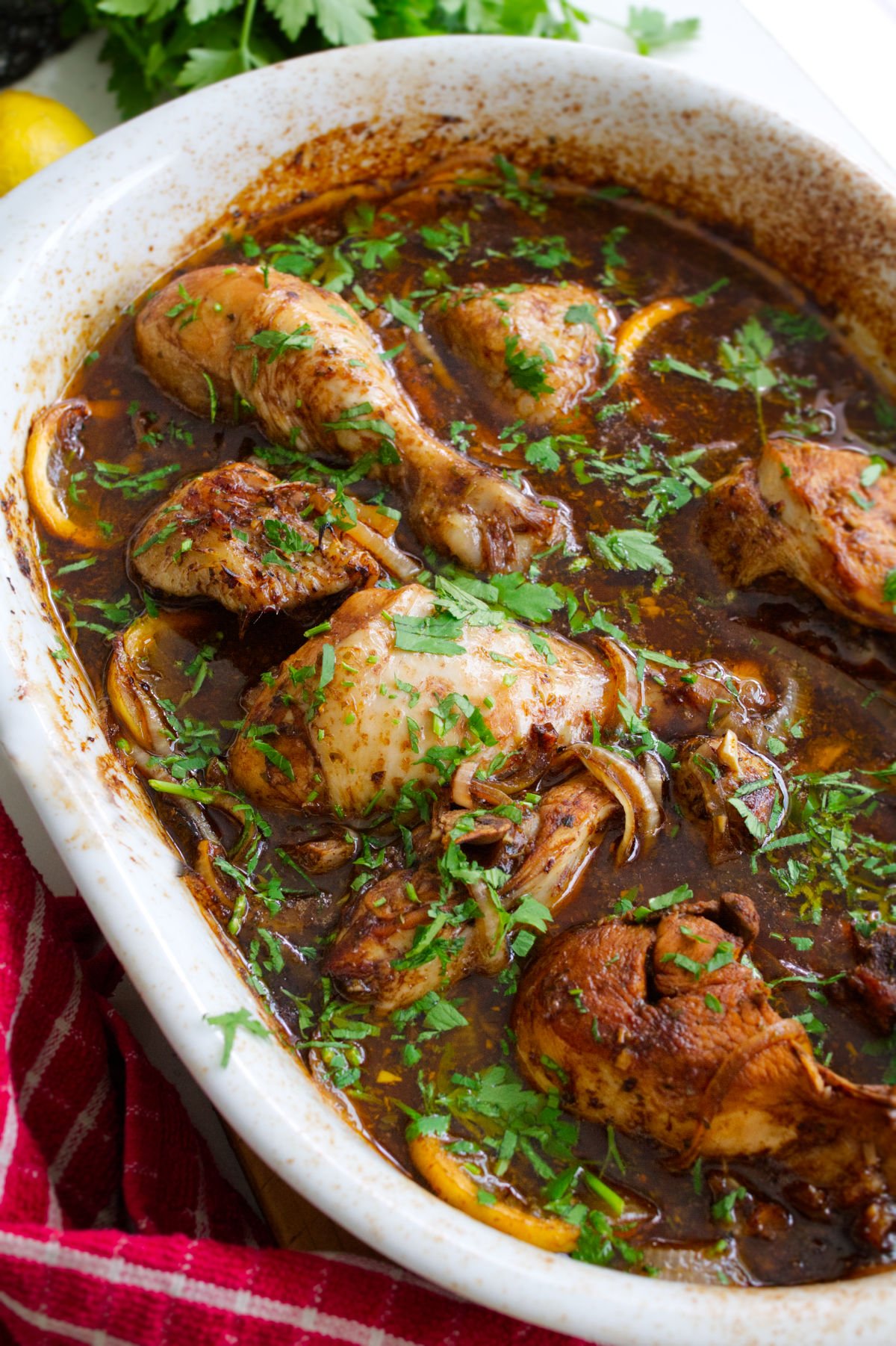
Leave a Reply